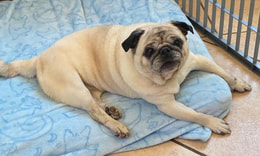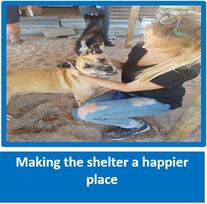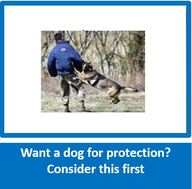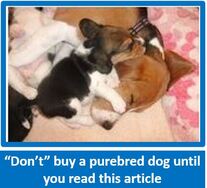muttmix

All breeds are prone to some sort of behaviour problems, and this applies even if you have a cross breed. It is always a good idea to see what breeds make up your cross breed, as this will give you more idea of why your dog is behaving in a certain way, allow you to stimulate him according to his needs, know about any genetic concerns and possible common conditions the breed it prone to. DNA identification is easy to do, and in the comfort of your own home. www.muttmix.co.za
Pugs - Common Behaviour Concerns
https://www.pugvillage.com/ - really lovely website with all things pug - articles, health. training etc, etc - worth a visit - enjoy!
https://www.pugvillage.com/ - really lovely website with all things pug - articles, health. training etc, etc - worth a visit - enjoy!
 Pic. Pug Rescue SA - details below. If you are looking for a Pug, please consider rescue first and foremost. if Pug Rescue SA is not near you, do search for another rescue in your area. https://www.facebook.com/PugRescueSA/
Pic. Pug Rescue SA - details below. If you are looking for a Pug, please consider rescue first and foremost. if Pug Rescue SA is not near you, do search for another rescue in your area. https://www.facebook.com/PugRescueSA/
For the most part, the Pug is a friendly and low-maintenance breed. These little dogs were specifically bred to be companion pets, so they are social and people-oriented. As is true for all dog breeds, however, the Pug does come with a few challenges. Keep reading to learn about the most common behavioral problems in Pugs.
Problem #1: Barking
Most small-breed dogs tend to bark more than larger dogs, though this is not always the case. The Pug has moderate barking tendencies as well as a moderate level of territorial behavior. If you find that your Pug is barking more than you would like, you may want to think about teaching him a “Quiet” command. Start by training your dog to bark on cue with a command like “Speak” and then work with him to teach him how to stop barking on cue with a verbal command.
Problem #2: Begging for Food
Pugs absolutely love to eat and many of them develop a tendency to beg for food. If you feed your Pug scraps from the table or give in to his whining, you are merely reinforcing this behavioral problem. To deal with it, start feeding your Pug all of his food and treats from his bowl – no exceptions. You can also feed him his meal when you sit down to dinner to reduce begging behavior.
Problem #3: Chewing on Things
All dogs chew on things and the Pug is no exception. If your Pug is chewing on household objects, buy him an assortment of chew toys to chew on instead. When you find him chewing on something he shouldn’t be, tell him “No” in a firm voice and take the object away. Immediately after, give your Pug one of his chew toys then praise and reward him when he starts chewing on that instead.
Problem #4: Housetraining
For some reason, small-breed dogs like the Pug tend to be a little more challenging to housetrain. Crate training is one of the most effective methods for housetraining with most dog owners seeing success within a few weeks. If you live in an urban area, you might want to consider indoor housetraining, though this approach comes with its own set of challenges. Whichever method you choose, be consistent in praising and rewarding good behavior and give your Pug enough opportunities to do his business in the designated area that accidents simply don’t happen.
Problem #5: Separation Anxiety
Because Pugs are such a people-oriented breed they are prone to separation anxiety. If your Pug develops this problem, try giving him a special treat or an interactive toy right before you leave and then take it away when you come home – this will help to negate any negative association he has with your leaving.
The behavioral problems discussed above are not unique to the Pug breed – any dog can develop these problems. What many dog owners don’t realize is that it is not actually their dog that is the root of the problem – it is them. The way you respond to your Pug’s behavior and your level of training will either reinforce or discourage problem behaviors like the ones listed above. If your Pug has any of these problems, follow the recommendations provided to deal with them.
Problem #1: Barking
Most small-breed dogs tend to bark more than larger dogs, though this is not always the case. The Pug has moderate barking tendencies as well as a moderate level of territorial behavior. If you find that your Pug is barking more than you would like, you may want to think about teaching him a “Quiet” command. Start by training your dog to bark on cue with a command like “Speak” and then work with him to teach him how to stop barking on cue with a verbal command.
Problem #2: Begging for Food
Pugs absolutely love to eat and many of them develop a tendency to beg for food. If you feed your Pug scraps from the table or give in to his whining, you are merely reinforcing this behavioral problem. To deal with it, start feeding your Pug all of his food and treats from his bowl – no exceptions. You can also feed him his meal when you sit down to dinner to reduce begging behavior.
Problem #3: Chewing on Things
All dogs chew on things and the Pug is no exception. If your Pug is chewing on household objects, buy him an assortment of chew toys to chew on instead. When you find him chewing on something he shouldn’t be, tell him “No” in a firm voice and take the object away. Immediately after, give your Pug one of his chew toys then praise and reward him when he starts chewing on that instead.
Problem #4: Housetraining
For some reason, small-breed dogs like the Pug tend to be a little more challenging to housetrain. Crate training is one of the most effective methods for housetraining with most dog owners seeing success within a few weeks. If you live in an urban area, you might want to consider indoor housetraining, though this approach comes with its own set of challenges. Whichever method you choose, be consistent in praising and rewarding good behavior and give your Pug enough opportunities to do his business in the designated area that accidents simply don’t happen.
Problem #5: Separation Anxiety
Because Pugs are such a people-oriented breed they are prone to separation anxiety. If your Pug develops this problem, try giving him a special treat or an interactive toy right before you leave and then take it away when you come home – this will help to negate any negative association he has with your leaving.
The behavioral problems discussed above are not unique to the Pug breed – any dog can develop these problems. What many dog owners don’t realize is that it is not actually their dog that is the root of the problem – it is them. The way you respond to your Pug’s behavior and your level of training will either reinforce or discourage problem behaviors like the ones listed above. If your Pug has any of these problems, follow the recommendations provided to deal with them.




